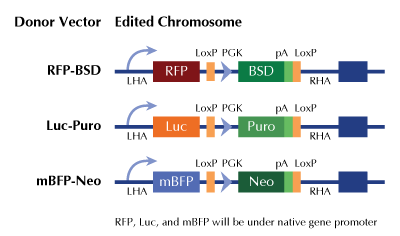beta Arrestin 1 (ARRB1) Human Gene Knockout Kit (CRISPR)
CAT#: KN201279BN
ARRB1 - human gene knockout kit via CRISPR, HDR mediated
Functional Cassette: GFP-puro Luciferase-Puro RFP-BSD
HDR-mediated knockout kit validation
USD 1,657.00
4 Weeks*
Specifications
| Product Data | |
| Format | 2 gRNA vectors, 1 mBFP-Neo donor, 1 scramble control |
| Donor DNA | mBFP-Neo |
| Symbol | beta Arrestin 1 |
| Locus ID | 408 |
| Components |
KN201279G1, beta Arrestin 1 gRNA vector 1 in pCas-Guide CRISPR vector KN201279G2, beta Arrestin 1 gRNA vector 2 in pCas-Guide CRISPR vector KN201279BND, donor DNA containing left and right homologous arms and mBFP-Neo functional cassette. GE100003, scramble sequence in pCas-Guide vector |
| Disclaimer | These products are manufactured and supplied by OriGene under license from ERS. The kit is designed based on the best knowledge of CRISPR technology. The system has been functionally validated for knocking-in the cassette downstream the native promoter. The efficiency of the knock-out varies due to the nature of the biology and the complexity of the experimental process. |
| Reference Data | |
| RefSeq | NM_004041, NM_020251 |
| UniProt ID | P49407 |
| Synonyms | ARB1; ARR1 |
| Summary | Members of arrestin/beta-arrestin protein family are thought to participate in agonist-mediated desensitization of G-protein-coupled receptors and cause specific dampening of cellular responses to stimuli such as hormones, neurotransmitters, or sensory signals. Arrestin beta 1 is a cytosolic protein and acts as a cofactor in the beta-adrenergic receptor kinase (BARK) mediated desensitization of beta-adrenergic receptors. Besides the central nervous system, it is expressed at high levels in peripheral blood leukocytes, and thus the BARK/beta-arrestin system is believed to play a major role in regulating receptor-mediated immune functions. Alternatively spliced transcripts encoding different isoforms of arrestin beta 1 have been described. [provided by RefSeq, Jan 2011] |
Documents
| Product Manuals |
| FAQs |
| SDS |
Resources
Other Versions
| SKU | Description | Size | Price |
|---|---|---|---|
| KN201279 | ARRB1 - human gene knockout kit via CRISPR, HDR mediated |
USD 1,657.00 |
|
| KN201279LP | ARRB1 - human gene knockout kit via CRISPR, HDR mediated |
USD 1,657.00 |
|
| KN201279RB | ARRB1 - human gene knockout kit via CRISPR, HDR mediated |
USD 1,657.00 |
|
| KN401279 | ARRB1 - KN2.0, Human gene knockout kit via CRISPR, non-homology mediated. |
USD 1,657.00 |
|
| GA100297 | ARRB1 CRISPRa kit - CRISPR gene activation of human arrestin beta 1 |
USD 1,657.00 |
{0} Product Review(s)
Be the first one to submit a review






























































































































































































































































 Germany
Germany
 Japan
Japan
 United Kingdom
United Kingdom
 China
China
